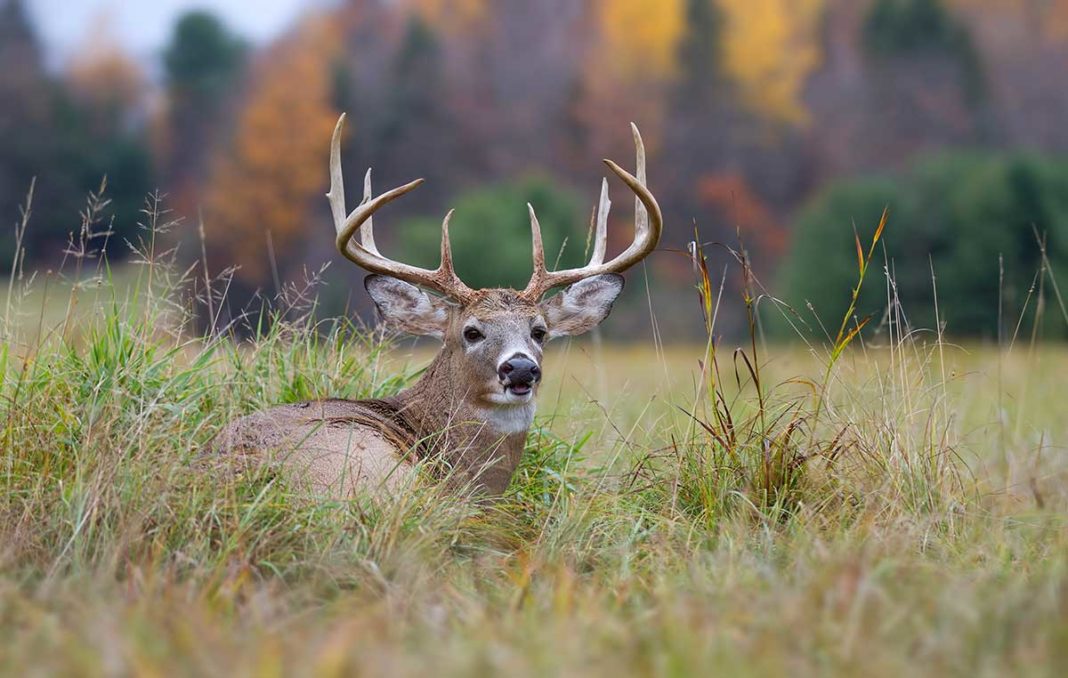MANITOULIN – Deer management is one of the keys to being able to get the opportunity for big healthy bucks and being able to harvest that trophy animal that most if not all hunters have dreamt about.
The Expositor talked to Ian Anderson, a deer expert in every way. He is a former long-time Conservation Officer with the Ministry of Natural Resources, Conservation and Parks, who has been a lifelong deer hunter as well. We also gleaned information from the website of Mossy Oak and Quality Deer Management for additional tips.
When asked what is one of the most important things to growing big healthy mature bucks on your hunting property, Mr. Anderson said, “I know what I do. To consistently have big bucks on your property you can’t shoot all the little male deer. Most people are happy to shoot anything, but if you want the opportunity to take a significant sized deer, do not shoot the small bucks.”
“A lot of hunters dream of the chance to harvest big bucks, and I’ve seen enough hunt camps where several larger bucks have been harvested and hung on the pole but harvesting many during one hunt may not be the best thing to do either,” said Mr. Anderson.
“The Quality Deer guidelines recommend managing the harvest of deer to a 50/50 split for males and female deer,” said Mr. Anderson. “In nature, there is an average of one-half male fawns and one-half female fawns born each year.”
“At our hunt camp and on the property we hunt on, we take some nice bucks but we take some does and fawns as well. We will take a few mature deer but the whole idea is to manage the herd so the younger deer can grow and get older,” said Mr. Anderson.
Mr. Anderson noted, “Habitat management is a critical component to a healthy deer population.” He explained, “What gets deer through the winter is having plenty of body fat (going into the winter). The body weight going into winter is key to their survival in a bad winter. Deer need a good summer range and plenty of food.”
“If you have habitat sufficiently managed on your hunting property and if deer have access to good available food that will help them build up fast reserves before the winter, they will survive most severe winters,” said Mr. Anderson.
In management for mast, removing undesirable trees, and cultivating and planting mast-producing trees can help nourish and attract wildlife. Ideally, 20 to 30 percent of your woodland should consist of these fruit and nut breaking trees. Deer love acorns, especially from white oaks, red oak and beech. Soft mast from wild apple trees, sumacs as well as domestic apple and pear trees will also attract deer and provide good nutrition.
Planting and maintaining food plots is another one of the annual activities necessary to help keep deer on your property.
In the spring it is recommended pruning mast-producing trees when trees are dormant (usually late February/early March depending on where you live); fertilizing mast-producing trees and patches of native vegetation; planting young dormant trees in early spring; protecting seedlings/young trees from wildlife; planting food plots for warm-season consumption; moving perennial food plots for weed control; thinning tree stands; discing (mid to late spring) to encourage warm-season plants.
Planting food plots for cool season consumption is always a good idea. In the fall, discing at this time of year will encourage cool season plants.
To help hold mature bucks on your property, Mossy Oak recommends creating transition corridors for mature bucks. Most land is open for prime deer habitat and big bucks don’t get old by travelling where they can often be seen.
Locate a natural potential travel route from bedding to feeding areas or between doe bedding areas and make it appealing to bucks by adding a variety of shrubs or tall annual grasses and partially felling a few low value trees. This serves two purposes. Beside offering cover, a lot of the species you plant will also offer food as will the hinge-cut trees. That will make the travel corridors even more appealing.
It is also recommended to provide minerals. Maybe you’re fortunate enough to have a natural mineral site on your property. If not, build one or more mineral licks to satisfy the deer’s need for macro and micro elements that they don’t get enough of from natural foods, crops and food plots.
It is also important to create or enhance staging areas. Crop field and food plots are attractive to deer but if they appear abruptly at the edge of open woods, mature bucks might not move into them until after dark. By adding or enhancing a staging area between the field and woods, older bucks will feel comfortable hanging out in these areas and perhaps even approach the plots in daylight.
It is also recommended to plant native warm season grasses. This will help to keep mature bucks on your property.
Habitats that are mostly open crop fields and mature woods can benefit from releasing and enhancing any shrubs and vines present and planting others. Also nurture any raspberry or blackberry plants on the property. These offer both food and valuable cover.
Build big buck bedding cover. Mossy Oak notes mature deer might walk through your land or venture onto it looking for does as the rut swings in. They might visit food plots you’ve created for a bite to eat but you’ll never have old bucks stay on your land without good bedding cover. “It’s critical!” stated Mr. Anderson.
Create a thermal refuge. To keep deer on your land during inclement weather, you need a thermal refuge. These can be anywhere from a half to several acres, close to the centre of your property when possible.
A dense grove of pines, spruce, or cedars offers deer thermal cover and shields them from blustery winds, snow and sleet in winter. The conifers are also immensely valuable as psychological security cover, offering great escape areas. When hunting pressure mounts on nearby lands, there’s nothing a buck craves more than thick cover and seclusion. His life depends on it. A grove of dense young evergreens in a secluded spot is just what he’s looking for. Don’t disturb these sanctuaries.
Plant oaks. Most properties managed for whitetails have some of these but you can improve their output by thinning greens around them. If you have enough open land, consider planting more oaks.
Give them fruit. They may not be important in the overall nutrition of a picture of a mature buck but trees of species like pear and apple offer treats that will hold and draw deer to your property.
As well, is it recommended to delineate sanctuaries. No matter how small your property, it’s vital to have some part of it placed off limits to any human activity except entering to retrieve a hit deer. It should have some cover, perhaps including some of your bedding areas and thermal cover sites. The rougher, thicker and steeper the terrain, the better.
“Managing the overall harvest of deer on a property and enhancing habitat are key,” said Mr. Anderson. He said on his hunt property, “We use quite a few trail cameras on our hunt lots in the summer and fall, in locations where we will hunt to assess what is on the ground pre-opening day. Quite often in our hunt camp, we will target one or two of the deer that we see on the camera. It doesn’t always work out but we still take some nice deer and some does and fawns each year. The whole idea is to take a few mature big deer and manage the herd overall for future years.”
Mr. Anderson added, “Predator control is important to manage the deer herd. I am in no way advocating for the eradication of predators but predators have to be managed just like deer. You can’t have a good deer population and an exceedingly high number of predators, or eventually the predators will eat themselves out of house and home.”





